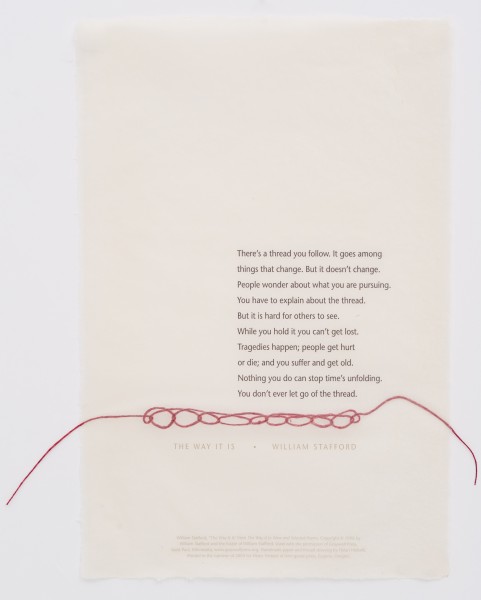How Long Did it Take?

Detail of The Wish, photo by Carol McIntyre
This is the most common question I get asked about my work: How long did it take you to make it? It was a frequent question at the unveiling of The Wish last Friday. And I have to say that I didn’t feel like I had a good answer, even though I had several chances to get it right.
It just isn’t that simple. Perhaps the most honest answer I gave was my entire life. Because really, if I hadn’t learned to make paper 22 years ago; if hadn’t perfected my technique in creating the shrunken paper disks; and if hadn’t thought a lot about dandelions and wishes… If I hadn’t learned how to ask for help when I need it – how to calculate the number of holes to drill in the central core, how to plot those holes on a sphere, – and if I hadn’t experimented with various attachments for connecting paper to wood, how could I possibly have made this piece?
I remember a lovely conversation I had with Kim Stafford a few years ago. I’d just created this broadside featuring his father’s poem The Way It Is, and he told me how someone had once asked his father (William Stafford) how long it took to write a particular poem. Stafford’s response was “my entire life”. I’m sure there was more to the explanation, and I’ve forgotten the particulars, but I completely agree with his answer!
I don’t take offense at the people who ask this question. I think they are truly in awe of what I do, they are not accustomed to making art or working with their hands, and they are eager to have a conversation. At least one young person came up and asked me the question, and I found myself wondering why he in particular wanted to know. Was he thinking of becoming an artist? In retrospect, I should have asked him (and the others) why they were asking. That might help me frame the question and come up with an intelligent answer, which I believe it is my responsibility to do.
For those of you who really want to know what went into the making of The Wish, here is a list of some aspects of the project. This doesn’t include several meetings I had with the staff at Anythink Huron Street Library, where the piece is now permanently installed:
Many hours of thinking, setting up an on-line form for collecting wishes, beating pulp, making 300 paper disks, laying down 1800 pieces of string between those paper disks, pressing water out of the sheets, lifting the sheets off of damp felts and placing them on a cutting mat, using a rotary cutter to separate two wet disk-shaped papers, transferring the wet disk-sheets onto dry pellons, once dry, cutting the disks into circular forms, sorting 500 bamboo stakes to find 300 suitable ones, whittling the ends of those stakes to fit into the 300 holes drilled into a turned wooden sphere, drilling those holes, attaching the paper dandelion seeds to the ends of each bamboo stake with a bit of putty, some epoxy and a brass escutcheon pin.
It really is a cumulative experience, and at this point I’m not keeping track of the hours (which is not a good business practice).
William Stafford’s poem so eloquently explains the bigger picture:
There’s a thread you follow. It goes among things
that change. But it doesn’t change.
People wonder about what you are pursuing.
You have to explain about the thread.
But it is hard for others to see.
While you hold it, you can’t get lost.
Tragedies happen; people get hurt
or die; and you suffer and get old.
Nothing you do can stop time’s unfolding.
You don’t ever let go of the thread.
I’d love for you to join in this conversation by leaving a comment: what is your thread and how do you answer the question “how long did it take you to make/do that?”


6 Comments
I love this answer– thanks so much for sharing the poem, it’s such a good explanation. I’ve started using that same answer for people who ask me how long it takes to make a particular piece of art. Some things take more time than others to make and assemble, but the years of life experience and context that have preceded the actual production are what makes art really possible –and hopefully– inspiring and magical.
Thanks, Suzanne. Yay to inspiring and magical!
So lovely to read the poem again, and see your beautiful rendition of it. I’ve never come up with an answer to this question that satisfies me, so I don’t have a marvelous suggestion, but I love the thoughtfulness you’ve brought to it. Hmmmm…
Thanks, Moe!
Hi Helen,
This post got me thinking, and next time maybe I’ll remember to ask people their reason for asking. I think all answers are relevant- it is an accumulation of life experiences, training and work; it is also the time you’ve actually been thinking about it (maybe 3 years? that’s approximately the time it takes for a book to happen for me from conceptualization to completion); and it’s also the actual production time. But when people ask, I get the sense that they are amaze that someone can put in the physical time, effort, and concentration to actually create something that they care about just for themselves, without instruction or a boss or a payday. I think they just can’t imagine that you actually did spend as many days as you did making paper circles, drilling holes, attaching them, and doing it over when it didn’t work. Beautiful piece- I wish I could see the wish in person.
Hi Sarah, I like the points you bring to the table: doing the work without because of an inner drive and working through failure. Thanks for your insight!